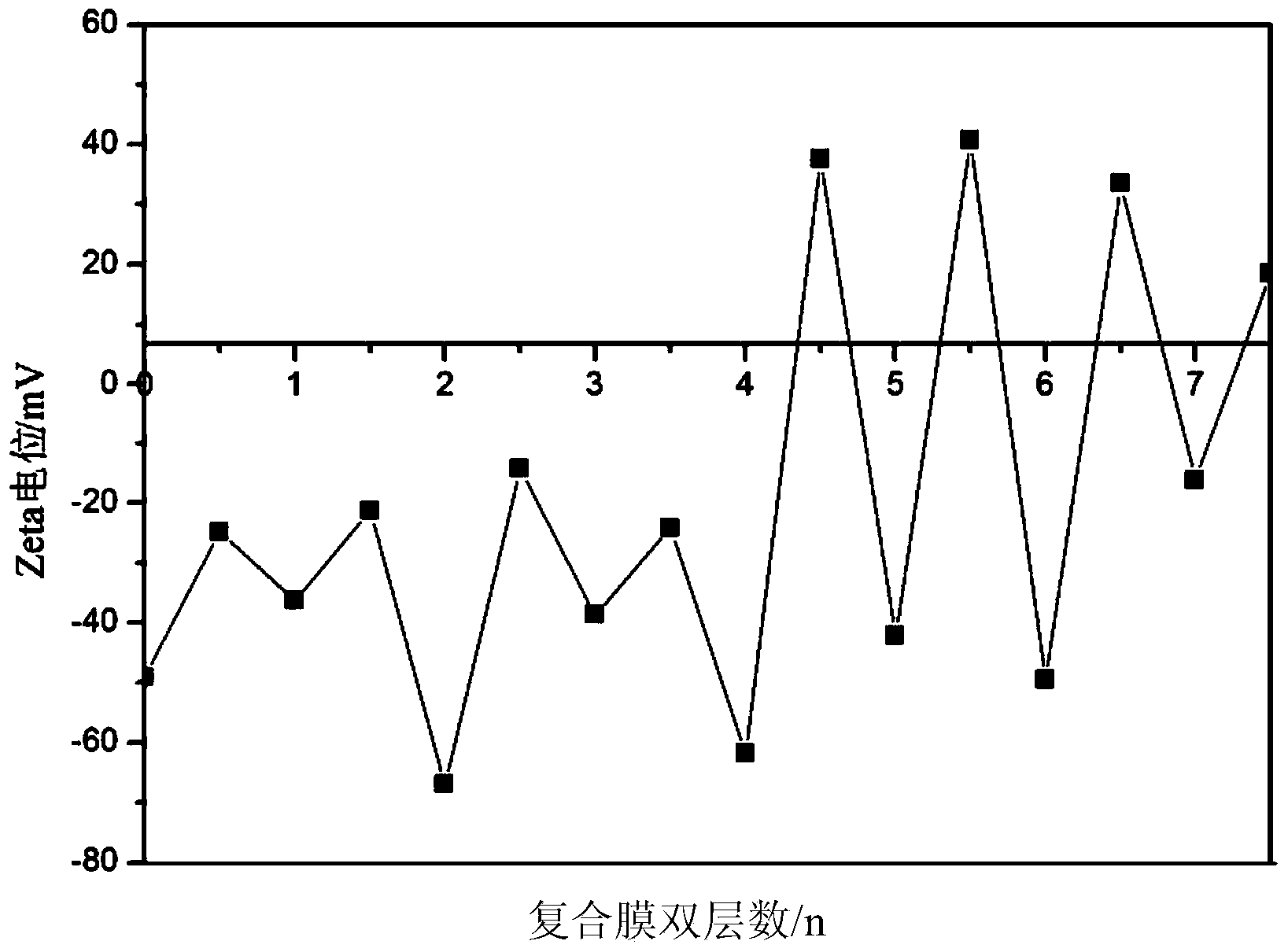Layer by layer self-assembly compound nanofiltration membrane based on natural cellulose polyelectrolyte and preparation method
A natural cellulose and composite nanofiltration membrane technology, applied in the field of membrane separation, can solve the problems of undiscovered natural cellulose polyelectrolyte composite nanofiltration membrane, and achieve good anti-pollution performance, cost reduction, and controllable membrane layer
- Summary
- Abstract
- Description
- Claims
- Application Information
AI Technical Summary
Problems solved by technology
Method used
Image
Examples
Embodiment 1
[0022] (1) Pretreat the base membrane to make its surface negatively charged: use polyacrylonitrile ultrafiltration membrane as the base membrane, immerse it in a 2.0 mol / L sodium hydroxide solution, and treat it at 30°C for 90 minutes. Take it out and rinse it repeatedly with deionized water to a pH of 7.
[0023] (2) Preparation of polyelectrolyte solution: Polydimethyldiallylammonium chloride (PDDA) is selected and dissolved in deionized water to prepare a cationic polyelectrolyte solution with a concentration of 7.0 g / L. Sodium carboxymethyl cellulose (CMC-Na) is dissolved in deionized water to prepare an anionic cellulose polyelectrolyte solution with a concentration of 1.0 g / L. Among them, when preparing an anionic polyelectrolyte solution, sodium carboxymethyl cellulose (CMC-Na) should be slowly added under stirring to prevent it from agglomerating and preventing dissolution. After stirring evenly, let it stand for 24 hours to defoam and make it fully dissolved.
[0024] (...
Embodiment 2
[0028] (1) Pretreat the base membrane to make its surface negatively charged: use polyacrylonitrile ultrafiltration membrane as the base membrane, immerse it in a 2.0 mol / L sodium hydroxide solution, and treat it at 30°C for 90 minutes. Take it out and rinse it repeatedly with deionized water to a pH of 7.
[0029] (2) Preparation of polyelectrolyte solution: Polydimethyldiallylammonium chloride (PDDA) is selected and dissolved in deionized water to prepare a cationic polyelectrolyte solution with a concentration of 5.0 g / L. Sodium carboxymethyl cellulose (CMC-Na) is dissolved in deionized water to prepare an anionic cellulose polyelectrolyte solution with a concentration of 2.0 g / L. Among them, when preparing an anionic polyelectrolyte solution, sodium carboxymethyl cellulose (CMC-Na) should be slowly added under stirring to prevent it from agglomerating and preventing dissolution. After stirring evenly, let it stand for 24 hours to defoam and make it fully dissolved.
[0030] (...
Embodiment 3
[0034] (1) Pretreat the base membrane to make its surface negatively charged: use polyacrylonitrile ultrafiltration membrane as the base membrane, immerse it in a 2.0 mol / L sodium hydroxide solution, and treat it at 30°C for 60 minutes. Take it out and rinse it repeatedly with deionized water to a pH of 7.
[0035] (2) Preparation of polyelectrolyte solution: Polydimethyldiallylammonium chloride (PDDA) is selected and dissolved in deionized water to prepare a cationic polyelectrolyte solution with a concentration of 5.0 g / L. Sodium carboxymethyl cellulose (CMC-Na) is dissolved in deionized water to prepare an anionic cellulose polyelectrolyte solution with a concentration of 2.0 g / L. Among them, when preparing an anionic polyelectrolyte solution, sodium carboxymethyl cellulose (CMC-Na) should be slowly added under stirring to prevent it from agglomerating and preventing dissolution. After stirring uniformly, let it stand for 18h to degas to make it dissolve fully.
[0036] (3) Th...
PUM
 Login to View More
Login to View More Abstract
Description
Claims
Application Information
 Login to View More
Login to View More - R&D
- Intellectual Property
- Life Sciences
- Materials
- Tech Scout
- Unparalleled Data Quality
- Higher Quality Content
- 60% Fewer Hallucinations
Browse by: Latest US Patents, China's latest patents, Technical Efficacy Thesaurus, Application Domain, Technology Topic, Popular Technical Reports.
© 2025 PatSnap. All rights reserved.Legal|Privacy policy|Modern Slavery Act Transparency Statement|Sitemap|About US| Contact US: help@patsnap.com

